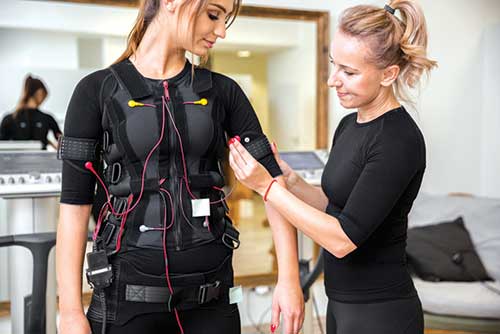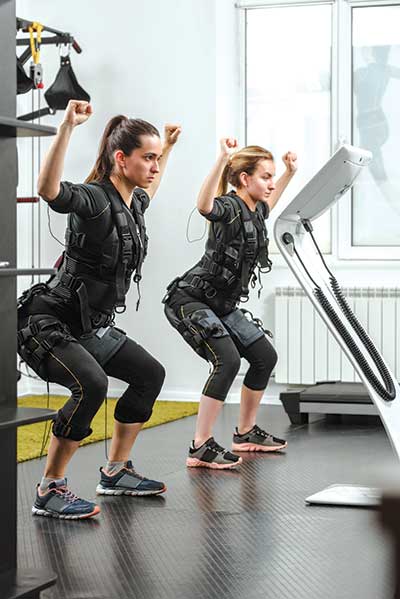You’ve probably seen this latest workout trend blowing up on social media – people seem to be wearing a jacket that’s strapped to wires hooked on to their muscles. If you’ve been wondering what that is, it’s EMS Training. If you’ve already heard about EMS Workouts, you’ve also probably come across the risks that are cited with regards to the form of exercise, and you’ve also probably read about it’s benefits. It is all a little confusing and convoluted, so we’re here to break it down for you…
What is EMS Training?
Electrical Muscle Stimulation or EMS is a tool used by physical therapists to rehabilitate patients recovering from surgery. It is used in cases where there is muscular inhibition due to swelling, weakness of the muscles or long periods of immobilisation, where a network of electrodes is attached to the muscle to involuntarily activate it in order to retain function.
To get a muscle to contract, the brain sends an electrical impulse to muscle fibres. In EMS training, the EMS suit integrated with electrodes does the same thing; it stimulates and therefore strengthens muscles. The suit, integrated with electrodes is connected to an EMS training machine or device and the intensity of current passed through each pair of electrodes can be individually altered and monitored via this device.
How does EMS Training work?
When one signs up for an EMS workout, they are put in a suit that is integrated with electrodes. While some suits look just like life jackets with wet pads that ensure the conduction of electric current is strong, other suits include skin-tight t-shirts and shorts. Hooked on to the EMS Training device, the suit activates the muscles using external electrical impulses. So as one is guided through a set of body weight and lightly weighted exercises such as squats, lunges, crunches, shoulder presses and planks, the electrodes target the particular set of muscles they are attached to. While the exercises mentioned seem particularly easy, the intensity of the current through the suit will work the muscles harder than a normal workout.
Are EMS Workouts safe?

We’ve got to admit that all this talk about electric muscle stimulation does sound scary. But experts claim that EMS workouts are perfectly safe for healthy people as long as the intensity of the current is carefully monitored and the devices and suits are in good condition and work perfectly as intended. One of the most common risks that EMS training poses is turning the impulses too high, which can cause the muscle to become tense and tear. It is recommended to turn the impulse down if one is experiencing pain during the workout.
EMS training is not suitable for pregnant women, people with epilepsy, pacemakers, bone injuries, coronary stents, open wounds and skin diseases. Those with fevers, weakness and general cough and cold should avoid EMS workouts as they will cause additional soreness and could worsen the health condition due to physical strain. A basic rule to follow is, if you have undergone any major surgery or health scare and if you have sustained any injury in the field of application of electrodes, it is best to avoid EMS training.
Why is EMS training so popular?
Apart from being a boutique workout that celebrities and social media influencers have been promoting, fitness facilities around the world who offer EMS training claim that it is a more effective way to tone muscles in a shorter amount of time.
EMS training is also believed to target harder-to-workout areas such as the hips and waist, and penetrates deep into the muscle. Whole-body EMS training helps burn fat around the stomach and waist.
EMS workouts are also good for muscle building in shorter exercise spans and improve blood circulation in skin, provided the impulses are controlled. Studies have also shown that EMS training can combat cellulite and increases collagen production.
Because EMS shakes up the muscle with external stimuli, it is recommended for people with back pain or weakness in the back, as it helps stimulate the muscles and strengthens them in the process. However, it is not recommended for people with back injuries, slip disc or any back related health problems.
It is also said that one can achieve the same results of a regular 90-minute workout session in a 20-minute EMS training session. What’s best – just two 20-minute sessions a week will help one inch forward to one’s fitness goals!


